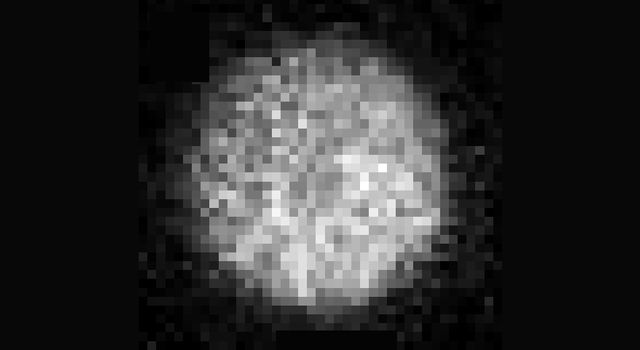News | January 7, 2002
A Texas-Sized Space Rock

For two centuries it was the largest known rock in the solar system. The Texas-sized asteroid Ceres, about 930 kilometers (580 miles) across, was the first asteroid ever detected. The space rock was identified in 1801 by astronomer Giuseppe Piazzi, a monk in Sicily and the founding director of the Palermo Astronomical Observatory. He noted over a few nights a shifting point in the sky that wasn't one of the planets, their moons or a star. Thus, he discovered the rock.
After discovering the asteroid, Piazzi was invited to join the Celestial Police, a group of 24 international astronomers looking for what they called "guest planets" between Mars and Jupiter. The Celestial Police noted that the spacing between planets was fairly regular, but that there was a large gap between Mars and Jupiter.
Soon other small bodies were discovered in that region (Pallas in 1802, Juno in 1804 and Vesta in 1807), so the Celestial Police concluded that not just one, but many minor planets had to exist in a main asteroid belt. The asteroid belt probably represents primitive pieces of the solar system that never managed to accumulate into a genuine planet.
German mathematician Karl Friedrich Gauss calculated from Piazzi's few observations that Ceres circled around the Sun once every 4.6 years or about 4 years, 220 days.
The asteroid has a very primitive surface, say scientists on NASA's Dawn mission, which will launch in 2006 and examine Ceres in 2014. The asteroid, like a young planet, contains water-bearing minerals, and possibly a very weak atmosphere and frost. Infrared observations show that the surface is warm.
NASA's Hubble Space Telescope observed last year that Ceres' surface has a large spot, which could be a crater formed when another asteroid struck Ceres. A second explanation may be that the spot is a darker substance in the asteroid's soil.
Recently, Ceres lost its claim to the title of biggest rock in the solar system. In July 2001, a larger object was found in the vast Kuiper belt of asteroids, stretching from 30 to 100 AU (2.8 to 9.3 billion miles away from the Sun.) This brightest and therefore biggest non-planet space rock, 2001 KX76, could be anywhere from 960 to 1270 kilometers (600 to 790 miles) across.
Right now, Ceres is less than three degrees away from the Sun, making it hard to see. In October, the asteroid will be bright enough to see with a little help from binoculars.
After discovering the asteroid, Piazzi was invited to join the Celestial Police, a group of 24 international astronomers looking for what they called "guest planets" between Mars and Jupiter. The Celestial Police noted that the spacing between planets was fairly regular, but that there was a large gap between Mars and Jupiter.
Soon other small bodies were discovered in that region (Pallas in 1802, Juno in 1804 and Vesta in 1807), so the Celestial Police concluded that not just one, but many minor planets had to exist in a main asteroid belt. The asteroid belt probably represents primitive pieces of the solar system that never managed to accumulate into a genuine planet.
German mathematician Karl Friedrich Gauss calculated from Piazzi's few observations that Ceres circled around the Sun once every 4.6 years or about 4 years, 220 days.
The asteroid has a very primitive surface, say scientists on NASA's Dawn mission, which will launch in 2006 and examine Ceres in 2014. The asteroid, like a young planet, contains water-bearing minerals, and possibly a very weak atmosphere and frost. Infrared observations show that the surface is warm.
NASA's Hubble Space Telescope observed last year that Ceres' surface has a large spot, which could be a crater formed when another asteroid struck Ceres. A second explanation may be that the spot is a darker substance in the asteroid's soil.
Recently, Ceres lost its claim to the title of biggest rock in the solar system. In July 2001, a larger object was found in the vast Kuiper belt of asteroids, stretching from 30 to 100 AU (2.8 to 9.3 billion miles away from the Sun.) This brightest and therefore biggest non-planet space rock, 2001 KX76, could be anywhere from 960 to 1270 kilometers (600 to 790 miles) across.
Right now, Ceres is less than three degrees away from the Sun, making it hard to see. In October, the asteroid will be bright enough to see with a little help from binoculars.
